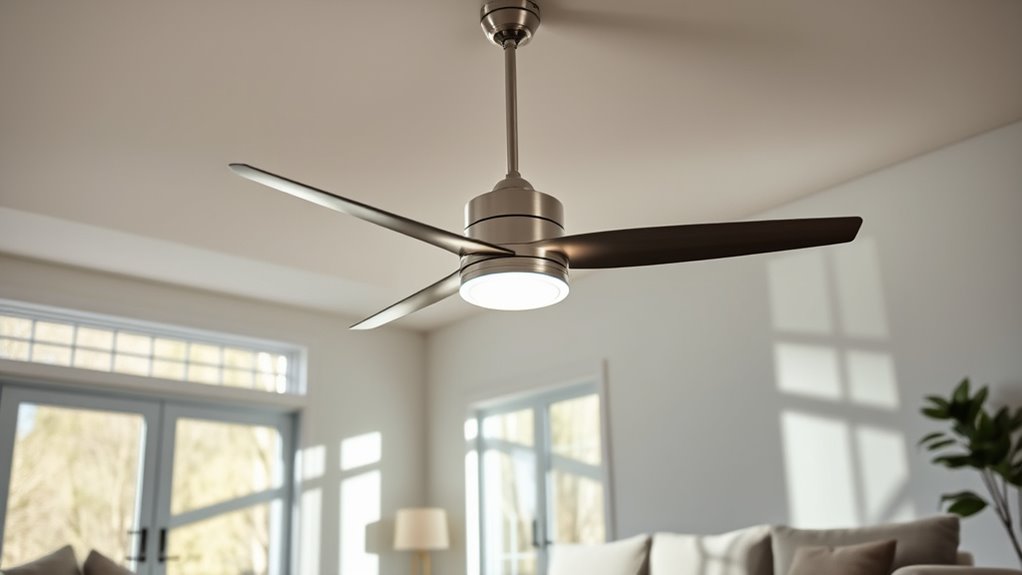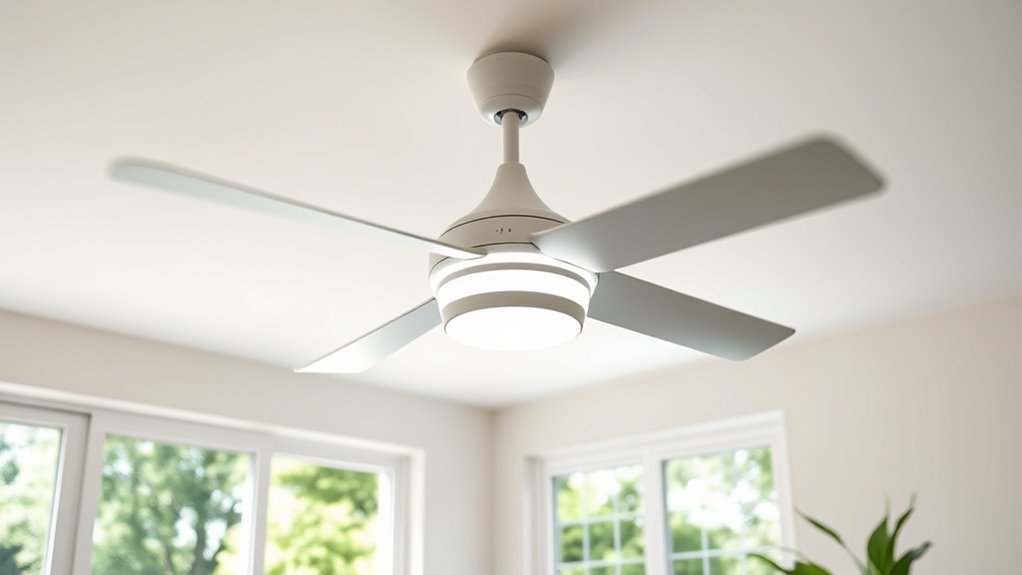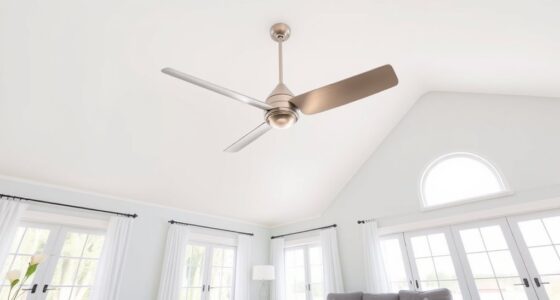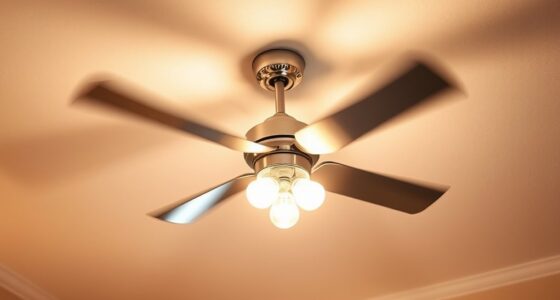Smart ceiling fans can lower your cooling bills by improving energy efficiency and working with your air conditioning system. They feature adjustable speeds, timers, and remote controls, helping you distribute airflow evenly and reduce unnecessary fan use. Additionally, automation through motion sensors and smart controls minimizes energy waste when the room is unoccupied. If you want to discover how to maximize savings and optimize your setup, keep exploring the benefits of smart ceiling fans.
Key Takeaways
- Smart ceiling fans improve energy efficiency with adjustable speeds and automation, reducing overall cooling costs.
- They distribute cooled air evenly, decreasing reliance on air conditioning and lowering energy bills.
- Integration with smart thermostats and timers optimizes operation, avoiding unnecessary energy use.
- Proper placement and balancing enhance airflow, maximizing cooling and reducing fan energy consumption.
- Automated controls and motion sensors prevent fan operation when rooms are unoccupied, saving electricity.

Have you ever wondered how modern technology can make your home more comfortable and efficient? Smart ceiling fans are a great example. They’re not just stylish additions; they can also help lower your cooling bills while maintaining a comfortable environment. By integrating smart fans into your home, you can maximize energy efficiency and save money on electricity. But to get the most out of these devices, understanding installation tips and how they contribute to energy savings is vital.
Smart ceiling fans enhance comfort and reduce energy bills through smart technology and proper installation.
First, smart ceiling fans are designed to be more energy-efficient than traditional fans. They often come with features like adjustable speeds, timers, and remote controls, allowing you to customize airflow precisely when and where you need it. This level of control helps you avoid wasting energy by running fans unnecessarily or at higher speeds than needed. When combined with your air conditioning system, a smart fan can help distribute cooled air more evenly, reducing the workload on your AC and cutting down on energy consumption. This synergy is key to lowering your cooling bill without sacrificing comfort.
When considering installation tips, it’s important to place your smart ceiling fan in the right location. Ideally, it should be centered in the room and positioned to promote good airflow. Proper mounting height also matters; the fan blades should be about 8 to 10 feet above the floor for maximum circulation. Ensuring your ceiling can support the weight of the smart fan is vital, so check the manufacturer’s specifications beforehand. Wi-Fi connectivity is a feature that enhances energy efficiency, so make sure your smart fan is within range of your network. During installation, verify that the fan’s blades are balanced to reduce noise and vibration, which can lead to unnecessary energy use and wear over time. Additionally, understanding the contrast ratio of a fan or its lighting components can influence your decision for optimal brightness and visual comfort in your space.
Once installed, you can control your smart ceiling fan via a smartphone app or voice commands, making it easy to adjust settings based on your schedule and preferences. Many models also include motion sensors or timers, allowing the fan to turn on or off automatically. This automation minimizes energy waste, especially when you’re not in the room or asleep. Additionally, pairing your smart fan with a smart thermostat can further maximize energy efficiency, as both devices work together to maintain a comfortable environment while reducing energy costs.
Frequently Asked Questions
Do Smart Ceiling Fans Work Effectively in Large Rooms?
Smart ceiling fans work effectively in large rooms when you choose models with powerful motors and adjustable settings. You can do DIY installation easily with clear instructions, saving time and money. Keep noise levels in mind—look for fans designed to operate quietly. Proper placement ensures even airflow, enhancing comfort. Overall, smart fans are a practical, energy-efficient solution, helping you stay cool without excessive energy use or disruptive noise.
How Much Energy Can a Smart Ceiling Fan Save Annually?
You can expect smart ceiling fans to deliver notable energy savings annually, often reducing your cooling costs by around 20-30%. These fans optimize airflow and allow you to control settings remotely, which enhances efficiency. The cost benefits add up over time, especially if you use them consistently. By upgrading, you’re investing in a smart solution that helps lower energy consumption and saves you money on your utility bills.
Are Smart Fans Compatible With Existing Home Automation Systems?
Think of your smart ceiling fan as a puzzle piece fitting neatly into your home automation system. Most smart fans are compatible with popular devices like Alexa, Google Home, and Apple HomeKit, making integration seamless. You can control your fan with voice commands or apps, ensuring device compatibility. As a result, your home automation setup becomes smarter and more efficient, turning everyday comfort into a simple, connected experience.
Can Smart Ceiling Fans Operate Without Wi-Fi?
Smart ceiling fans typically rely on Wi-Fi for remote control and automation, but some models offer offline operation. If Wi-Fi dependency is an issue, check if your fan has manual controls or a dedicated remote. Many smart fans allow offline operation via these controls, so you can still turn them on or off without an internet connection. However, advanced features like voice commands or automation may require Wi-Fi.
What Is the Typical Lifespan of a Smart Ceiling Fan?
Imagine your smart ceiling fan as a wise old tree, standing tall and strong. Typically, these fans last around 10-15 years, thanks to durable, energy-efficient motors and smart integration that help reduce wear and tear. Just like a tree that adapts and thrives, your fan’s lifespan depends on proper maintenance. With good care, it continues to serve you efficiently, making your home more comfortable for years to come.
Conclusion
Smart ceiling fans are like a gentle breeze guiding your home toward savings. By adjusting their speed and timing, you can keep cool without wasting energy, making your bills feel lighter. They work quietly in the background, turning your space into a well-choreographed dance of comfort and efficiency. So, embrace these smart fans—they’re the steady heartbeat of a cooler, more budget-friendly home. Let them lead you to smarter, greener living.









